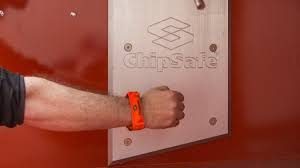
It was December 2015 and Mason Cox’s first day on the job in Kings Mountain, NC. The 19 year old was working for Crawford Tree Service when something went terribly wrong. Cox was loading brush into a Vermeer BC1500 wood chipper and suffered fatal injuries when he was pulled into the equipment.
Mason Cox’s preventable death is one of 113 examined by Julia Zhu and Kitty Gelberg with the New York State Department of Health. In a new paper published in the American Journal of Industrial Medicine, Zhu and Gelberg analyzed 34 years of data on work-related deaths in the U.S. involving wood-chippers. Their interest in the topic stemmed from Zhu’s own investigation of two wood chipper-related fatalities (here and here.)
Of the 113 deaths characterized in their paper, 55 of them occurred in 2007-2016. Twenty-two of the deaths in this 10 year period involved the worker suffering fatal injuries from being pulled into the wood chipper.
The feed wheels on wood chippers are powerful and efficient—capable of pulling in two feet of branches per second. Zhu and Gelberg call them the most dangerous part of a wood chipper. A worker standing near the end of the feed tray on a typical wood chipper can be pulled into the equipment in less than 3 seconds.
Besides the data tables and synopses, the authors note that safer technology is available to prevent “caught-in” fatalities with the equipment. They reference three patents, one dating back to 1997, designed to prevent users from being pulled into wood chippers. They write:
“These include a metal detector that can reverse the feed wheels upon detecting the presence of a metal chip worn by an entangled worker. An electrical sensing system or radio frequency identification technology can also be used to shut down a chipper. Manufacturers should utilize these technologies to develop more effective self-rescue devices.”
Too few employers or manufacturers have adopted this type of technology. Instead, we are stuck in the “be safe out there” mentality. It’s the mindset that insists the answer is safety training. It’s the approach that says more red stop buttons and red panic bars are the answer. Surely if there are enough of shut-off buttons, a worker could reach one to smack and shut down the feed wheels.
But as Zhu and Gelberg aptly note:
“When a worker is being rapidly pulled into a chipper, in addition to the physical constraints, human factors such as fear, confusion, and panic, can further impede a worker’s ability to self-rescue.”
In my own quick search, I learned that a patented device invented by Jeff and Mark Buchanan is integrated into wood chippers manufactured by Morbark. Workers wear small velcro wrist and boot bands that triggers the sensor and halt the feed wheels.

Jeff Buchanan (who runs his own tree service company) petitioned the Cal/OSHA’s Standards Board in 2015 urging it to consider a regulation to require the safer technology.
Cal/OSH and Standards Board staff recommended that the petition be denied. Their rationale included that the wrist and boot bands will potentially experience “wear and tear” and workers may “neglect to don the accessories.” (I think those are lame excuses. That’s like saying we shouldn’t require safety googles because workers may forget to wear them.) The staff also raised concerns about intellectual property rights because Buchanan holds the patent on the sensing device.
[I initially reported that the Standards Board denied the petition. Thank you to readers for providing correct information about the status of the petition.]
The Cal/OSHA Standards Board made its decision about the petition in January 2016. The 6-person panel wrote:
“Having carefully read and considered the Petition, Division Evaluation, and Board Staff Evaluation, the Petition is GRANTED to the extent that the Division identify and explore the existence of additional passive sensing device technology.
If technology is identified, the Board staff will convene an advisory committee meeting to discuss the merits of passive sensing devices.”
I am pleased to read the Board’s call for an evaluation of safer technology for wood chippers. I’m confident they were recalling information from California’s Fatality Assessment and Control Evaluation Program’s own investigations of worker deaths involving wood chippers. I use in my classroom a video they produced about one of these horrific deaths. It demonstrates well the need for protections that go beyond training to ones that embrace the hierarchy of controls.
The Michigan-based equipment manufacturer Morbark has a licensing agreement with Jeff Buchanan to integrates the sensor technology in their wood chippers. I spoke to Morbark’s Kevin Cotter about the ChipSafe ® Operator Safety Shield. It’s a feature that’s available on their newer wood chippers—for just a few thousand dollars. ChipSafe ® can also be installed after-market. It is in use in the U.S. and elsewhere.
I was surprised by Morbark’s affordable price for ChipSafe ®. Just a few thousand dollars? I say that is well worth the investment—and investment that could prevent someone from being pulled into a wood chipper. Morbark appears to be the only manufacturer of equipment for forestry, tree care and the like that offers this safer technology.
Thumbs up to to Julia Zhu and Kitty Gelberg for their analysis of wood chipper fatalities. They get a big high five for amplifying the important message that engineering controls–such as sensing devices that can shut down the feed wheels on a wood chipper—are the most effective way to save workers’ lives.
Their paper pointed to the patents. That led me to learn that the safer technology is available and in use. We should be expecting employers to adopt it.
[Update (Nov 6, 2018): The New York Department of Health issued their final report on the investigation of the May 2016 wood chipper fatality mentioned above. The report makes several recommendations and reiterates the availability of safer technology!]

You have an error in your article. The petition was not rejected by the Standards Board. See: https://www.dir.ca.gov/oshsb/documents/petition-549-adopteddecision.pdf
Please not that the Standards Board actually granted the petition and will hold an advisory committee meeting to discuss passive safety devices on wood chippers
Thanks to both of these commenters for pointing out the error in my post. I updated it with the correct information.
woodchippersafetyshield.com Has videos and articles to read about this subject matter
There is a letter from Tcia (Tree care industry association) you would be shocked
at its content. It speaks against passive safety. Not sure how to get it to you.
They sure as heck don’t want passive safety on wood chippers. Reach out to me and I will forward it over. The advisory committee meets Jan 29th 2019 In Sacramento Ca.j Jeff Buchanan
Jeff,
Thanks for alerting me to the TCIA letter. I would love to have it (and probably blog about it.) You can email it to me at cmonfort at GWU [dot] edu.